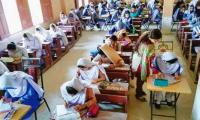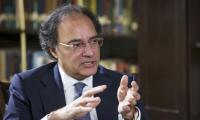The State Bank of Pakistan, in its recent monetary policy statement announced it would not cut the discount rate, which will remain at the highest rate of 13.25 percent at least for the next three months.
This was unexpected, though we have a high inflation rate (in the double digits). Most economists were of the opinion that the State Bank should reduce the discount rate least two base points in order to promote domestic investment, necessary to achieve economic growth.
Now the question is: ‘Will this high bank rate help control the uncontrolled prices in Pakistan?’ What will be the possible consequences of this high discount rate? Why have the concerned authorities failed to control the prices in the last three months with the same 13.25 percent bank rate?
The answer to all the above mentioned questions is simple, yet requires a clear understanding of the structure of Pakistan’s economy. Inflation in Pakistan is measured by an index called the Consumer Price Index (CPI). This index consists of more than 270 commodities with different weightage assigned to different commodities according to their significance.
It is astonishing to learn that the majority of the commodities (more than 50 percent by some estimates) are imported items. Now the answer to the first question lies in the last sentence. How can you control the prices of imported items by simply escalating the discount rate? We all know that the prices of imported items depend mainly on the exchange rate of an economy.
The rupee having depreciated more than 40 percent in the last couple of months, you can no longer expect the prices of imported commodities to settle down. That is what we are facing nowadays in the shape of escalating prices. Again, it is very shocking and worrisome at the same time that the State Bank of Pakistan has no direct control on 50 percent of the price hike because it came from the import sector. So technically, it is not simply the discount rate which can control the price level in the economy (when we keep in mind the current economic structure of the Pakistani economy).
On the other hand, through its policies, the State Bank discourages domestic investors with this high discount rate, so we may face a full crowding-out effect if the concerned authorities fail to reconsider their policies.
It is quite surprising that the incumbent government is hopeful for economic recovery with the prevailing serious loopholes in the policies. The current account balance is a term which the incumbent government is using to deceive the common citizen and to prove its economic competency. Having said that, the government claims that we have achieved current account balance which, in their opinion, is an economic milestone achieved by the government.
If the government keeps discouraging imports through higher tariffs – as a result, our per year imports dropped down from approximately $60 billion to $30 billion – we may face a huge current account surplus in the near future. But this is not the solution to our problem.
By intentionally closing your economy to international competition, you are, in a true sense, promoting incompetency which results in distortions. We have to have a strong export sector to stabilize our economy. In my opinion, the value of export is the true depiction of our economy. Unless we witness a good increase in the value of exports, we cannot say that our economy is on the right track. Because export is linked with market efficiencies and of-course competitiveness of our economy.
Competitiveness and efficiency is something we cannot achieve without having all the pillars of the economy working in an efficient way. The government needs to define their priorities if they are serious about economic recovery.
Recently, the National Tariff Policy was launched by the federal government for the very first time in our history. Some bold steps have been recommended in the policy to support the import of raw materials which is used in the production of exportable final goods which in turn helps in reduce trade deficit. This is a serious step towards stability, if implemented in its true spirit.
The only way to come out from this vicious circle is to concentrate on the export sector, coupled with domestic private investment. The discount rate needs to be adjusted so as to provide opportunities to the domestic investors.
An economic model like what economist Keynes proposed in the Great Depression needs to be implemented rather than adopting the pessimistic approach of austerity drive. This is what is needed to make economic activity happen in real terms, which will then have multiple positive impacts on our economy. The second recommendation is to make your domestic industry strong enough to compete in the international market by providing favourable conditions to them.
The writer heads the department of economics at the University of Swabi.
Email: arsalan@uoswabi.edu.pk
People attend the funeral of those killed during a protests demanding the subsidy on electricity and wheat prices in...
Electric power generating wind turbines and solar panels can be seen. — AFP/FileThe government of Bangladesh is...
Pakistani youth wait for their turn for a Capital Development Authority job entry test in Islamabad. —...
a Pakistani employee of the state-run Islamabad Electric Supply Company , takes a meter reading with his smartphone at...
A session in the Pakistan Literature Festival held in Quetta is seen on May 17, 2024. — Facebook/ACPKHIWhen you...
PPP Chairperson Bilawal Bhutto-Zardari routinely talks about engaging them with some solid plans







